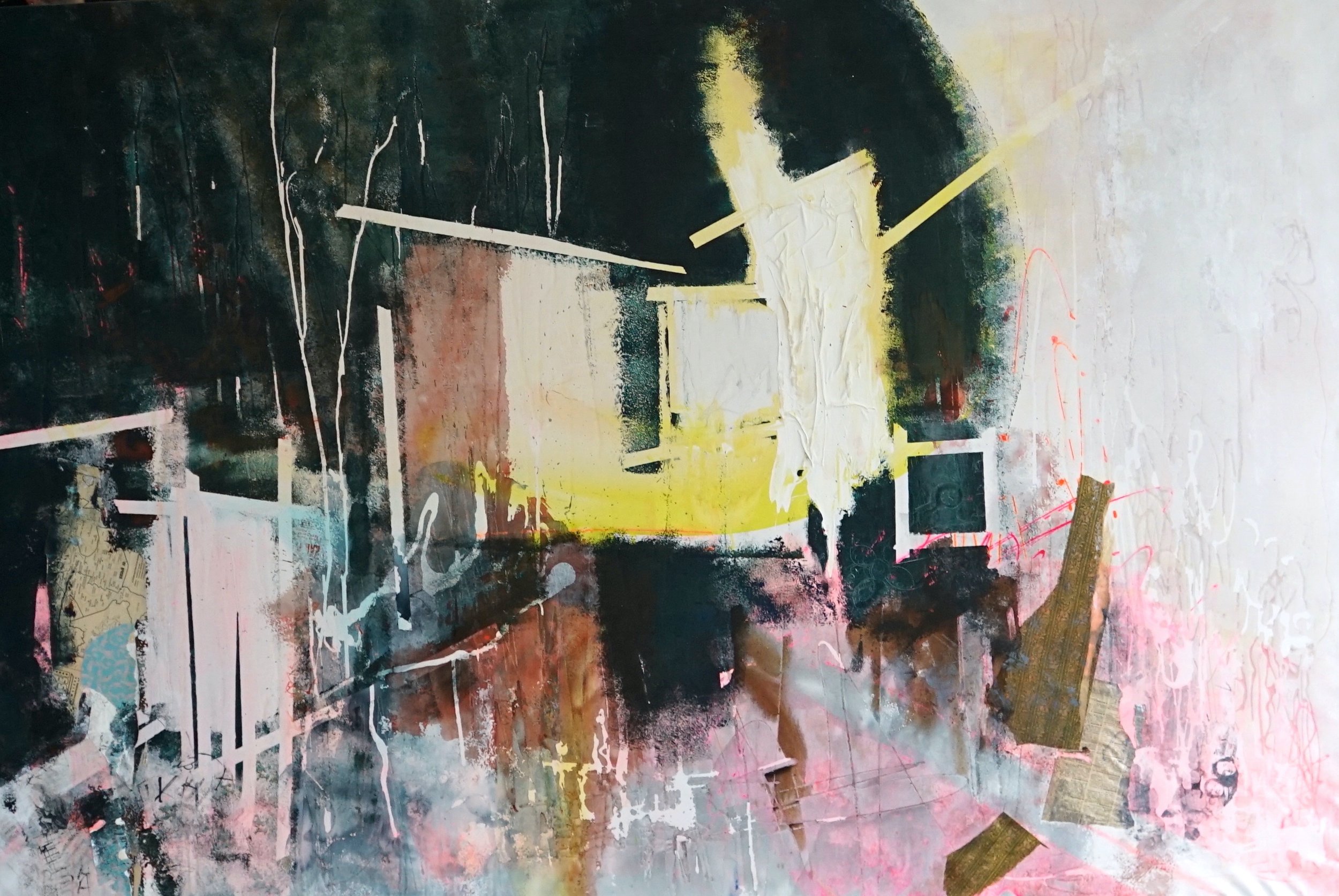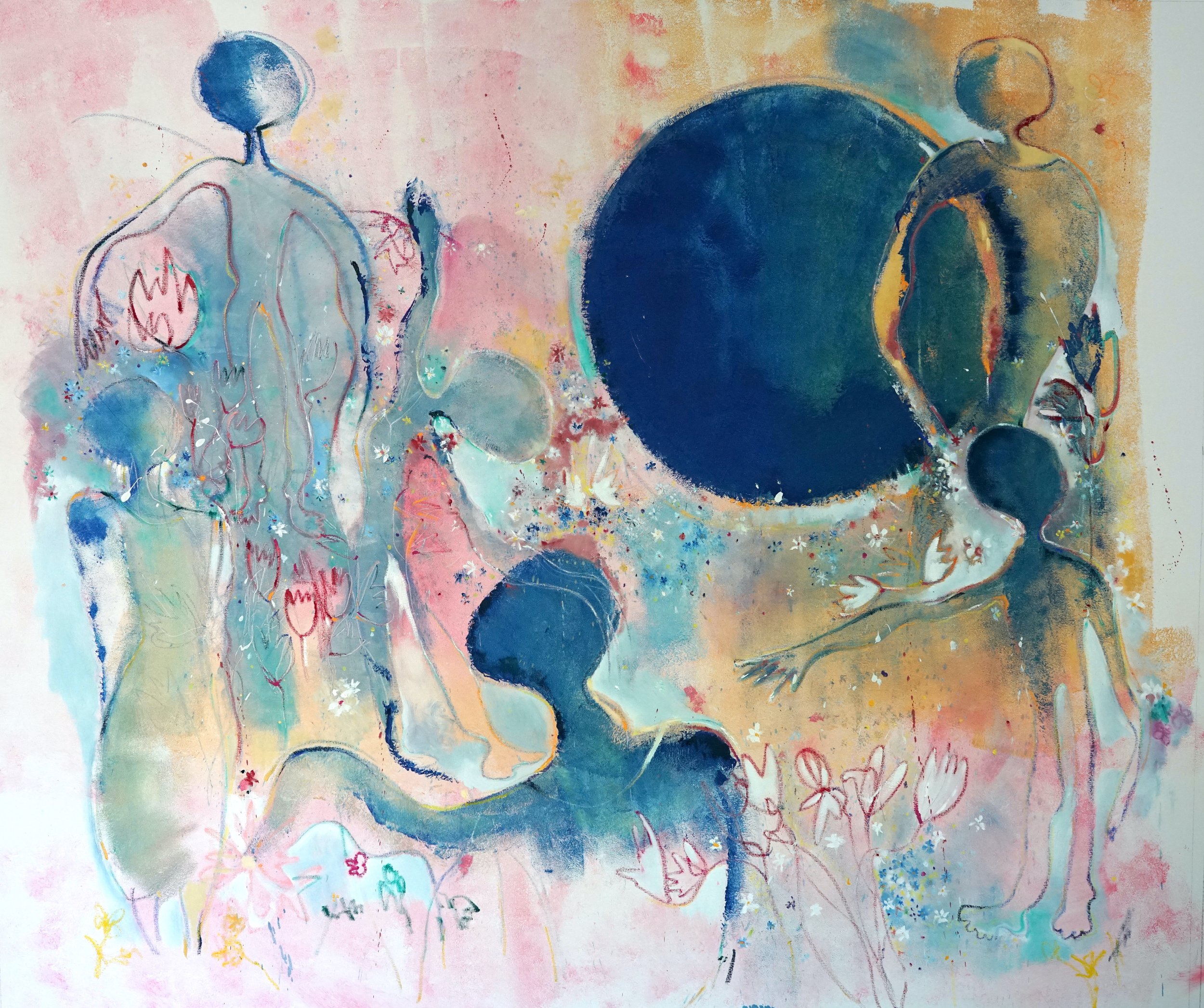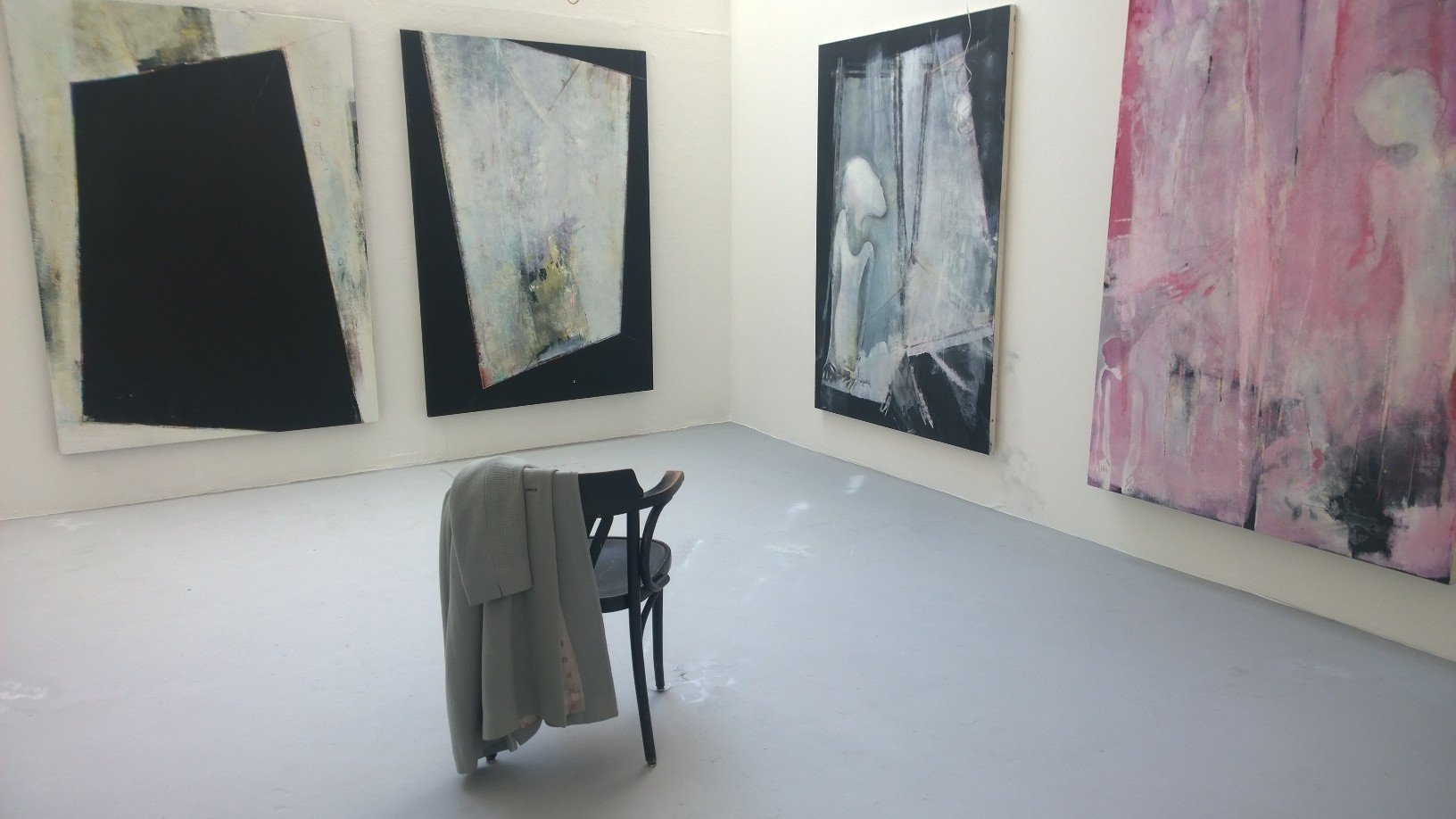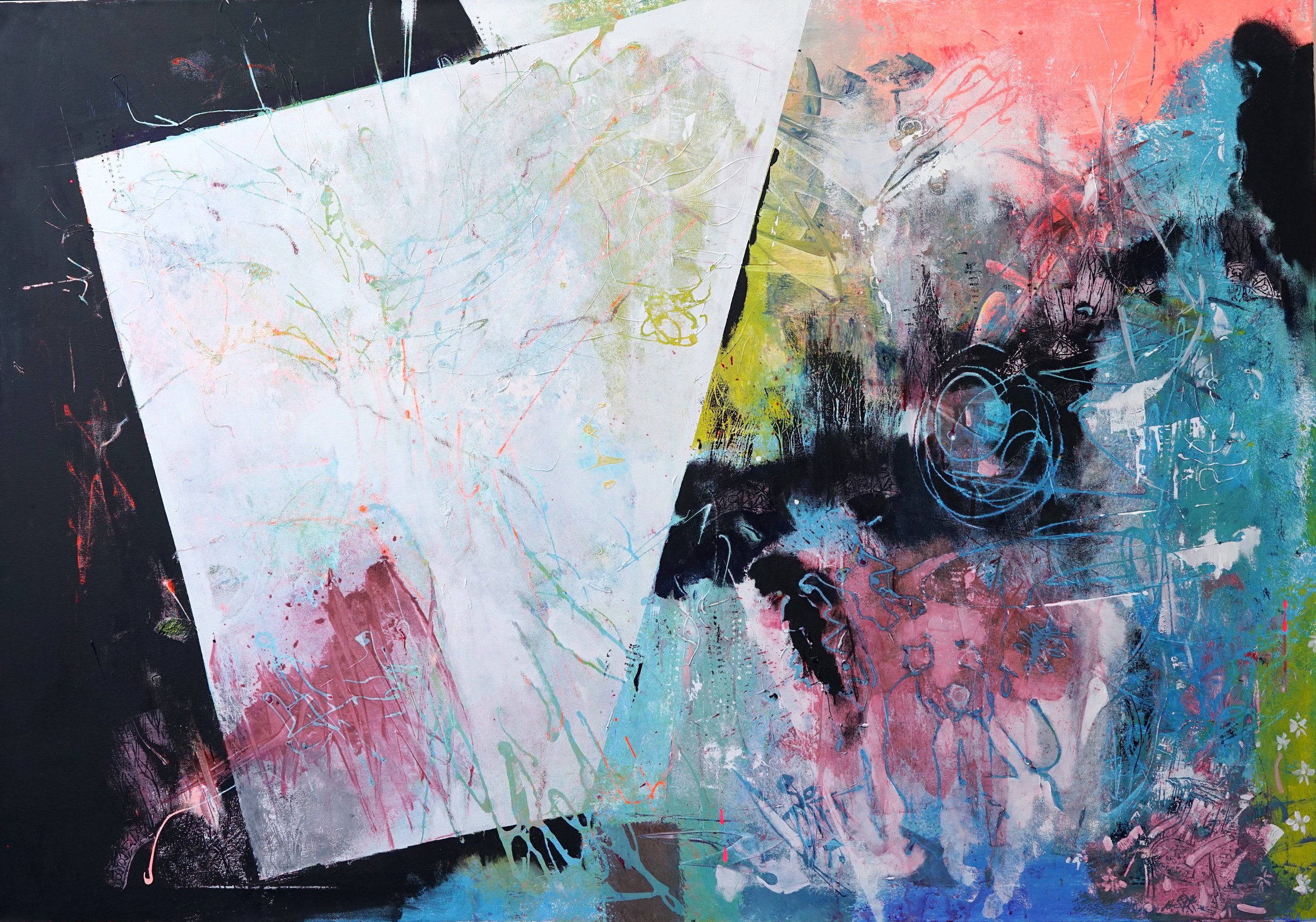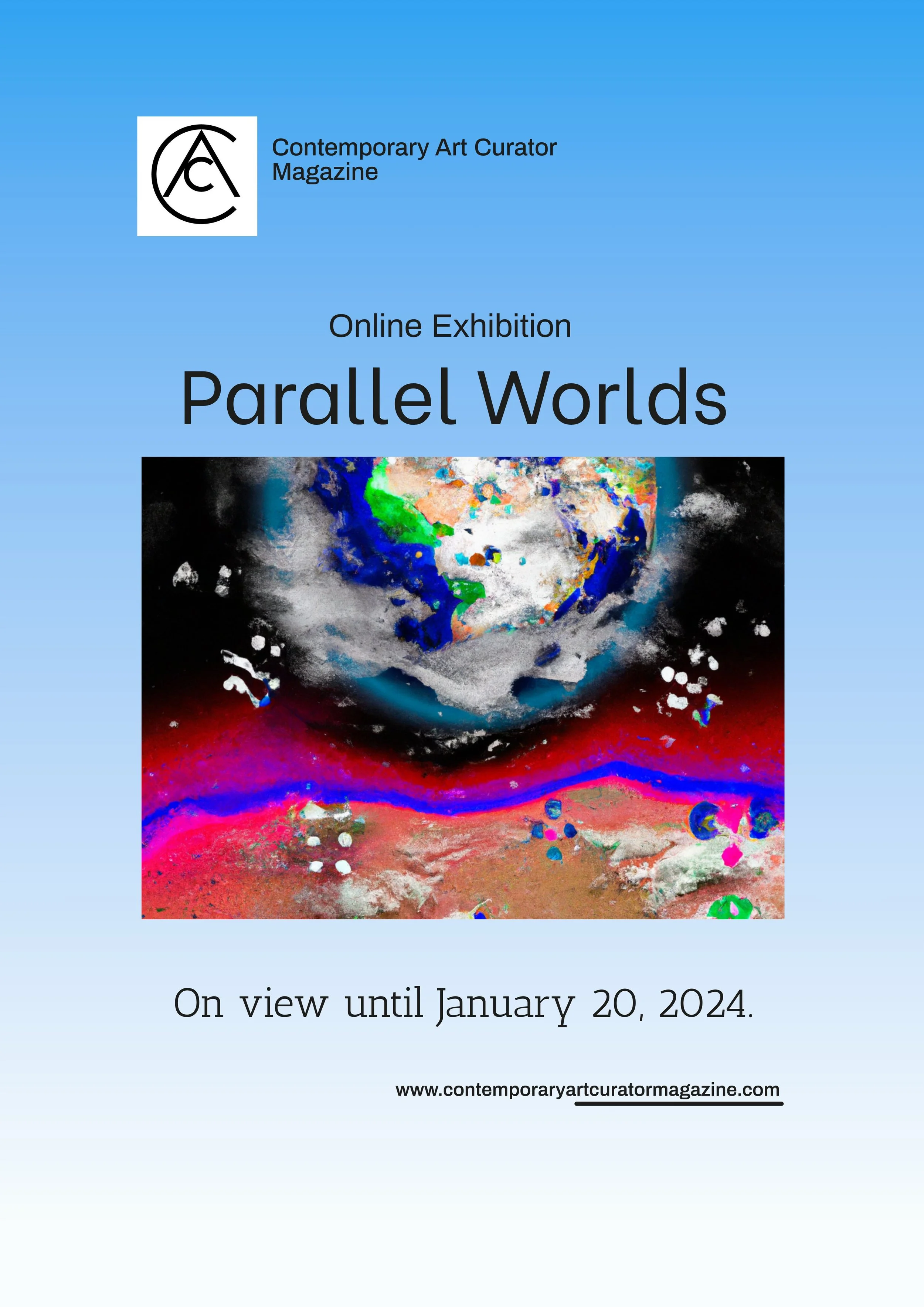Interview with Olga Goldina Hirsch
OLGA’S PAINTINGS: THEIR SYMBOLISM AND TECHNIQUE
Olga Goldina Hirsch is an artist with her own personal mythology, and her own complex symbolic universe.
I absorbed and unconsciously channelled the aesthetics of early 1920s Soviet avant-garde posters in my works on paper. Soviet posters were known for their directness and use of simple basic colours. In my practice, I adopted certain elements and techniques of the Soviet poster design.
The futurist elements in these posters, later blended with the Soviet visual culture and conceptual art from the 1970s, influenced my artistic approach and style.
~Olga Goldina Hirsch
Her artworks document the dynamics of inward journey towards recovering the obliterated memory, from the initial gaping voids and blank spaces present in the compositions, towards the airy, light, vibrant and open inspirational cosmic spaces, replete in meanings. From them, you can trace the trajectory of her inner artistic, spiritual and personal journey, which still continues. Her artworks are like palimpsests, and each viewer can focus on different layer.
Her journey starts from opening her “black square”, i.e. from reclaiming fragments of the long- forgotten memories from the “black holes” of oblivion. The artist attempts to find her own foothold in the void represented by the colour white.
With the time, she realises that this void is not entirely blank, but is replete with information. As she is able to find only titbits of this information, her works appear as collages, made of old maps, old snapshots, family drawings, soundscapes, poetry and recovered documents and photos.
In my view, my visual language reflects my identity and nature, my cultural memory, the movements of my soul and my aspirations to be free. It corresponds to the traumatic experiences of the generation of my parents who grew up in the USSR and other Eastern European countries under the Soviet rule. My visual language speaks of the subsequent dissociation these generations experienced and behavioural patterns they adopted in order to survive: to erase from memory, to avoid knowing, to suppress one’s thoughts, to stifle one’s own voice, to blend in, to be like everybody else.
In my work, I link these behaviours to the “failing memory” of the tragic moments in my familial history and the history of the USSR. These failing memories are represented as empty spaces in one’s family albums: the gaps in time, total blackouts, with memories erased and nothing left to remember.
To convey the atmosphere of those times, I created the series titled The Family Album Which Does Not Exist. I had no wish to reconstruct the lost historical facts, but rather to invoke the long- buried emotions and memories of the heart.
... My choice of colours is dictated by my emotions, memories and dreams. I used a combination of metallic and fluorescent paint to relate the flashback-like moments in time, flashbacks being my sudden, clear memories of certain past events. To communicate these states, I used a special palette on black paper, in order to suggest associations with an overexposed film – a poignant metaphor for my family archives destroyed by NKVD (KGB).
~ Olga Goldina Hirsch
Growing up in Moscow during the USSR era, how did your environment shape your artistic vision?
I believe, I should start answering your question by telling of my family, because it is the family where the child’s tastes are first formed, and intellectual interests developed. There are certain artistic and literary traditions running in our family, too, which, I believe, shaped me as an artist.
Artistic avant-garde tendencies and preferences ran very strong in our family. Early in her career, my maternal grandmother acted as a graphic designer in the architectural bureau of the Vesnin Brothers (famous Constructivist architects). She also briefly worked for Moisei Ginsburg, the father of the Soviet Constructivist architecture. I remember my grandmother sharing her stories of meeting Le Corbusier during his visit to Moscow in the late 1920s. Many years later my grandmother recognised some of her 1920s designs exhibited at the “Moscow-Paris” show which took place in June-October 1981, at the State Pushkin Museum of Arts (and at the Pompidou Centre of Arts in Paris prior to that).
As a child, I used to live in the famous “Writer’s house” in the centre of Moscow. Among its residents were once writer Mikhail Bulgakov and poet Osip Mandelshtam. Unfortunately, that house was pulled down in mid-1970s to give way to some nondescript faceless military headquarters.
My grandfather Nikolay Kostaryov was a writer, a member of the Futurist movement and an associate of the Russian futurist David Burliuk. Grandfather became first widely known due to his futurist novel trilogy “The Yellow Devil” written in co-authorship with Venedict Mart. However, his most popular work was his series of reportages titled “My Chinese Diaries”. It became the true hit and stood five editions. “My Chinese Diaries” narrated about my grandfather’s time in China during the rule of Sun Yat-sen (until 1925 and a year later). Alas, the book also proved to be my grandfather’s undoing. He was accused of espionage in favour of Japan and arrested in 1941. He died in a gulag prison in 1942.
Back to my childhood, we lived in the very city centre, within a walking distance of all major museums, such as the Tretyakov Gallery, or the Pushkin Museum, with its rare collection of Impressionist and modernist art. My grandmother had an extraordinary taste, and, as I now understand, style. I have accumulated a rich repertory of visual impressions and basic knowledge of art history under her caring and informed tutelage. As a child of eight, I could unmistakably identify the artworks by Matisse, Cezanne, Van Gogh, Fernand Léger, or Modigliani. Modigliani, with his tragic life and his moving artistic destiny, was, indeed, incredibly special to me.
At that time in my life I also devoured biographies of artists, musicians, and writers in great quantities. I also began to write short stories and illustrate them. While at school, I would design and draw posters and classroom newspapers. Nowadays, I realize that this was how I absorbed the Soviet propaganda poster style, with its straightforward language, its graphics, colour range, stencelling and lettering. All this you may find in my current work, especially in various graphic series.
On my dad’s side, the family was very musical: they were all musicologists, performing pianists, or composers. My dad knew the history of painting very well and painted himself. His father, my grandfather, was a famous surgeon and an amateur painter at that! When he was young, he even designed movie posters.
My mother was a highly creative person. She had been expected to become an artist by her parents, whilst my father was supposed to become a doctor. It turned out that my brother and I finally made their dreams come true: my brother is now a medical professional, whereas I have become an artist!
Surprisingly, I never studied art or aspired to become an artist in my Moscow years. Different members of our family were excellent draughtsmen, but they all chose to follow non-artistic career paths. In the same manner, I initially thought of becoming a music art critic, like my aunt, but I never summoned the courage or took the risk. I applied to a medical school instead and began to study science, which is also a creative discipline, if approached properly.
You mentioned growing up with a sense of freedom. How has this influenced your approach to artistic expression, particularly in a context where freedom might have been limited for many?
Freedom, and creative freedom in the first place, was prized above all else in our family. And this probably answers the question, why my relatives had chosen not to become artists. In Soviet times, being a successful artist meant that one successfully channelled the State propaganda to the masses. It also meant that one had to paint in the Soviet realist style. If one refused to do so, one could have been branded as a “formalist”. Those who refused to paint in the Soviet realist style and could not get a job or professional commission because of that were branded as “parasites”. They also could not get access to painting materials (such as brushes, oils, or canvases) or to painters’ studios, as those were distributed via the centralised Union of Artists among its members. This is how many nonconformist artists and poets went underground and became dissidents. My parents were the children of the Thaw (a period of greater freedom that followed after the death of Stalin) who valued openness, freedom of speech and integrity. My mother (daughter of Nikolay Kostaryov, who had been repressed by the Stalin’s regime) was a brave, optimistic and romantic person. She was self-sufficient, self-reliant and never feared anything, except for heights.
Speaking of freedom, I should probably mention the feeling of fear. My grandmother and my father constantly lived in it. To me that was incomprehensible, I ignored it. I was hovering in some imaginary empires of my own.
So, when I talk of freedom in such circumstances, I refer to the internal freedom, the ability to make one’s conscious choice.
I am also grateful to my father who taught me to take charge of my own life and assume the responsibility for my actions rather than put the blame on authorities or other external factors. In case of failure, I was taught to blame myself, not the circumstances. That is how I grew up knowing that everything in my life depended on me and my choices. At the same time, I was never afraid of trying things out and make mistakes.
I changed my professional career path several times and every time I succeeded. I studied biology and got my PhD. In the perestroika years, when I faced a personal and professional crisis, I went into medical business and established my own company. Freedom to me is, in the first place, the opportunity to develop my talents and skills, to follow my personal and professional choices.
I ended up in London after I married for the first time in my life. For me, this was the beginning of an exciting journey.
After relocating from Moscow to London in 2011, you embarked on formal art studies. How did this educational experience in a new city shape your perspective and approach to art compared to your earlier self-taught methods or informal learning in Moscow?
After I moved to London, I found myself living inside a beautiful fairy tale. This feeling is now gone, but back then everything seemed magical to me. That experience brought me back to my childhood. And some British habits seemed to have emerged straight out of my childhood days: leaving a key under the doormat, small bakeries with bread loaves on wooden shelves, which had to be picked off with tongs – exactly like in old quaint Moscow bakeries in Arbat. People were friendly, polite, calm, smiling, exactly like the people in my part of Moscow. I also found the Brits to be an immensely creative nation. And this is how I gradually began to look for the learning opportunities. And yet, I had no experience of painting as a craft.
I decided to take some drawing classes in our local community centre. There I was told that I needed to continue honing my artistic skills. Then I took a short course at the Putney School of Art and Design, which was very informal and very inclusive. The learning process was so unobtrusive and so well organised, that one could end up with the feeling that everything that we learned during the classes we picked up easily and effortlessly, as if of its own accord and without much interference of our course tutor.
This was my very first experience of the British educational system, where every student is seen, heard, understood and carefully guided. We were taught a little bit of everything, but that was sufficient to start painting. I received my first course certificate at this school, and decided to study further. I realized that I needed to take more classes. I began taking regular life drawing classes, three times a week, six years in a row. I believe, this is where my Soviet schooling with its systematic approach revealed itself. I believed that one should master the skill beginning from the very basics, and drawing is the basics of any art.
In the process, I realised that I wished to obtain an MA in Fine Art, and this also stimulated me to keep mastering various drawing techniques and keep on improving. This way, I embarked on my Master’s degree, having already learned something and having mastered some basic skills. This helped me a great lot because at that level we learned to search and obtain a context for our artwork.
How have the distinct cultural and artistic environments of Moscow and London influenced your artistic evolution, particularly during your formal art studies in London? Can you pinpoint any specific elements from each culture that have significantly impacted your artistic voice or technique?
I believe that I have partly responded to your question earlier. However, if we speak of the art education in Moscow and in London, major Russian art schools still follow a traditional academic curriculum. One has to master major important artistic skills and techniques first, learn to draw and paint from nature; and only after that one can move towards abstraction and other experimental techniques. Russian is a solid academic approach, but it can also kill one’s own artistic vision. In London, exactly the opposite is true: one is encouraged to search for one’s own artistic language and method of self-expression, and stay in a continuous state of experiment.
Perhaps, the truth lies somewhere in the middle. One needs to study academic disciplines but should also be given sufficient freedom to pursue one’s artistic vision. When I arrived in London, or to be more precise, in the West (as I also mean Europe and the USA) I became exposed to contemporary art. All these years, since I had moved to the UK, I have not missed a single art exhibition (well, almost). To me that was a totally new challenge, which also taught me to accept, embrace and understand something previously unfamiliar. I learned a lot. I do not think that such a revelatory experience would have been possible in Russia.
Your artworks are part of private collections worldwide. How do you feel this global reach has influenced your artistic identity, and what do you think attracts such a diverse audience to your work?
Some people just like my works, as my paintings may resonate with them. Initially, I did not keep track of who purchased my paintings and where they travelled to.
However, I have started to do so now, as I receive more invitations from private collectors and various charitable organizations to participate in their projects, as was the case with the Copelouzos Family Art Museum, Athens, Greece. They even acquired several works for their museum collection.
I did not take any particular efforts to contact them, they found me themselves. And I am pleased that my paintings ended up with the people who seem to understand what my work is about. I also participated in several art projects run by the Brooklyn Library, but unfortunately it had to close.
If you ask me about what draws different people to my works, I still would not be able to give you the answer. Perhaps, something is stirred deeply within their souls when they look at my artworks. I work with memory, with notions of transgenerational trauma, and also with the sense of release from the past, the experiences of healing and freedom. Perhaps, they can intuit this in my works and connect to the sentiments expressed in my paintings?
I try not to express my ideas in a very complex language and occasionally simplify the plot, but I tend to get carried away. Currently, I am looking to expand my outreach and establish contacts with new galleries and collectors. I am still looking for “my audience”, who enjoy being intrigued by complex, multi-layered artworks, with their own philosophy.
Can you share some key moments or decisions in your career that you believe were pivotal in leading to your current success as an artist? How did these moments shape your path?
I think, my arrival to the UK was such a fateful moment. Moving to live to a new country, one suddenly sheds their former self and needs to learn a new language, establish new contacts, new social links and new sense of identity and abandon all former ideas of self. To me this challenge was a blessing in disguise, as I realised for the first time in my life that I needed to paint!
Then I became aware that in order to do that, I had to study. I first wished to understand if I could become a professional artist, if my impulse was worth the effort. And only then, when I had the chance to mix with the experienced and beginner artists, I became to understand myself better. This process took a long time, two years of work, earnest effort, self-doubt and soul-searching. I spent six subsequent years working on my drawing, printing, and illustration skills. I mastered various painting techniques. And yet, that was not enough. I came to realise that a contemporary artist in London must be expert in contextual contemporary painting. So, this is how I ended up applying to a comparatively small and traditional City & Guilds of London Art School.
What has eventually transpired to me, is that the artist should never stop learning. This is a life-long process. Obviously, I felt more confident after I got my MA degree. It gave me a certain sense of independence. I am more certain of my ability now, I feel somehow validated in my pursuit of an artistic career.
In your view, what does success mean in the art world, and how do you measure it in your own life and work? How has your definition of success evolved over the course of your career?
Success is necessary for an artist, but each artist has a different definition of success. For me, success means being part of the London art community, being accepted, understood. It also means being invited to participate in exhibitions and various artistic and cultural initiatives.
What advice would you give to young artists, especially those who might be growing up in challenging or restrictive environments, about finding their voice and expressing themselves through their art?
It is very difficult to give advice to someone you do not know. I do not particularly to impose myself on others in this sense. Everyone has their own path and knows themselves better than other people.
I would only say that an artist needs to be simultaneously bold and sincere, vulnerable and ready to experiment, introspective and wishing to reach out to the world. An artist is also someone who is ready to lose one’s own self and rediscover it again. It is a person who never stops at what has already been done, never rests on the laurels. In my own case, I discovered that there is a child still alive within me, and childhood is a state of utmost sincerity and authenticity in one’s creative expression; it is also a passion for constantly learning something new.
What I also realised in the process, was that I possess many qualities essential for being an artist.
Looking ahead, what are some upcoming projects or artistic endeavors you're particularly excited about? Are there new themes, techniques, or collaborations you plan to explore in your future work?
Indeed, I have several projects in tow, but they are still in preparation, so I cannot talk about them just yet. I can only say, that at the moment some of my artworks are part of the Art on the Underground programme in London, and my painting and a poem will again feature on the screen of the Times Square in New York on 31 December.
Talking of collaborations, I would love to try my hand in some large urban design projects, I really admire street art. I am also hoping to show my White Room installation, which brings together painting and sound, in a professional gallery or museum milieu.
I would also be delighted to work as part of the stage design team somewhere on Broadway: I used to make sets for school and amateur plays and I still remember how greatly I enjoyed that! I am aware that these are ambitious wishes, but I have always been ambitious in a positive way, and this made my life very eventful and interesting. I just do not wish to stop!



